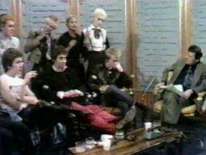
Back
 |
On the 1st of December 1976, the original line-up of the Sex Pistols (Rotten, Cook, Jones, Matlock) appeared on Thames
Television's 'Today' programme. Hosted by Bill Grundy, this was a live news / current affairs show which was broadcast
at teatime in the London area only. The band Queen had been booked to appear, but their late withdrawal saw the Pistols, whose
Anarchy In The UK single had just been released, take their place. Click here
to read a transcript of the infamous interview. The rest, as the cliché goes, is history. Grundy died in 1993. Poor Bill
Grundy! Back |
 |
Roger 'Syd' Barrett was the original singer and lyricist in Pink Floyd and was responsible for the early classic psychedelic
pop of the band's first three singles and debut album Piper at the Gates of Dawn (1967). The commercial failure
of the third single, Apples And Oranges, and Barrett's increasingly unpredictable behaviour (exacerbated by lysergic
drug use) led to him leaving the band in 1968. He produced two charmingly idiosyncratic solo albums, The Madcap Laughs
and Barrett (both released in 1970) before retiring from the music industry and returning to Cambridge, where lived reclusively
until his death in July 2006. Television Personalities have covered numerous Barrett and Floyd songs. While studio recordings of Apples And Oranges and the live favourite Bike have been released, the band have additionally played live versions of Interstellar Overdrive and Flaming (both from Piper) and Set the Controls For the Heart of the Sun (from Pink Floyd's second album). The legendary unreleased Barrett-Floyd song Vegetable Man has also been played live. It has also been reported that the band recorded Jugband Blues (one of the last songs Barrett recorded with Pink Floyd), which is as yet unreleased. It is also worth noting that the long version of David Hockney's Diaries includes the line 'Isn't it good to be lost in the wood', taken from the solo Barrett song Octopus, and Long Time Gone from the I Was A Mod album includes a line from Piper's Matilda Mother ('Oh mother, tell me more'). Back |
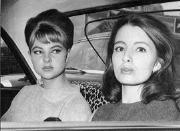 |
In July 1961, the British Secretary of State for War, John Profumo, shared a sexually charged frolic with goodtime girl
Christine Keeler in the swimming pool of Cliveden, the Berkshire mansion owned by Lord Astor. At the same time as seeing Profumo,
Keeler was also having an affair with a Russian naval attaché, Yevgeny Ivanov, about whom allegations of espionage later surfaced.
Amidst accusations that national security had been breached, Profumo initially lied to Parliament regarding his involvement with
Keeler. He was later unmasked and compelled to resign, in June 1963.
Stephen Ward, the society osteopath and painter who first introduced Keeler to Profumo, Ivanov and Lord Astor, was then charged with living off
immoral earnings. During the trial in 1963, Keeler's friend Mandy Rice-Davies gave evidence in court that she and Lord Astor had slept together.
Ward committed suicide before the jury returned their verdict. Back Pictured: Christine Keeler (right) and Mandy Rice-Davies (left), photographed during the trial of Stephen Ward. |
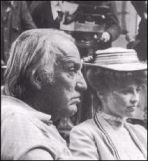 |
American film director. Losey started out working on stage productions in the 1930s and '40s, before graduating to educational and
documentary films. In the late '40s, he progressed to directing full-length feature films. An early highlight was The Boy With Green
Hair (1950), a parable about attitudes towards pacifism. Accused of having Communist sympathies during the McCarthy witch hunts, Losey
moved to England in 1952 and worked under various pseudonyms until the release of The Gypsy And The Gentleman in 1958. It is
Losey's work in the Sixties which established his reputation, starting with The Damned (1963), with Oliver Reed.
Amongst his best work were the three films he made with the writer Harold Pinter. These were The Servant (1963), Accident (1967)
and The Go-Between (1971). Other highlights from this period include the anti-war drama King And Country
(1964), the mod spy spoof Modesty Blaise (1966) and Figures In A Landscape (1970), which starred Malcolm McDowell.
Losey's films suffered mix fortunes in the 1970s and '80s, with Monsieur Klein (1976) being a highlight. The director's final film, Steaming,
was released posthumously in 1985. Back Pictured: Joseph Losey and Julie Christie on the set of The Go-Between. |
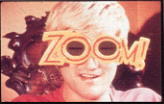 |
British artist, photographer and stage designer, born in Bradford in 1937. After a brilliant prize-winning career as a student at the Royal College of Art (1959-62), Hockney went on to achieve international success by the time he was in his mid-20s, becoming the best-known British artist of his generation. His early works utilised magazine-style images of such things as consumer goods, which placed him (despite his protests) amongst artists of the Pop Art movement. Hockney has spent much of the last forty years in the United States. He first visited the US in 1961, and returned in 1964 - 67 to teach at the universities of Iowa, Colorado, and California, finally settling permanently in Los Angeles in 1978. His relocation to the States gave rise to the exploration of such themes as sea, sun and sky, displaying a preoccupation with light. He is renowned for his pieces of work depicting Californian swimming pool scenes, often featuring young men (eg A Bigger Splash, 1967). Openly gay, there is often a strong homo-erotic content in Hockney's work. In the 1970s he achieved acclaim for his work as a stage designer for operas. In the 1980s he experimented much with photography, producing, for example, photographic collages and - since 1986 - prints created on photocopiers and fax machines. David Hockney's Diaries is the title of a 1973 documentary in which the artist told the stories behind photographs from his own private collection. Back |
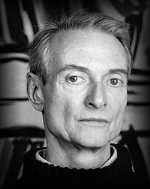 |
American painter who was a founder of the Pop Art movement, and is most famous for his influential and widely imitated comic-strip creations. At the start of his career, Lichtenstein experimented with a variety of modern art styles, producing a number of abstract expressionist works depicting scenes from the Old West. In the early Sixties, his depictions of Disney characters and bubble gum wrappers developed into the style that has become synonymous with his art. He began by painting illustrations from commercial publications such as mail order catalogues and advertisements, then adopted a comic-strip style representing such themes as romance, war and science fiction, often created on a large canvas. These works were characterised by hard-edged figures, bright primary colours, text balloons and famously, the use of Benday dots. This was a process used in commercial printing to achieve half-tones, which Lichtenstein adopted on a large scale (he was to augment this later with stripes). Lichtenstein's Whaam painting of combat aircraft (1963) was adopted by Dan Treacy and Ed Ball for the name of their record label. Other well-known Lichtenstein creations from this period are The Kiss (1962), Drowning Girl (1963), We Rose Up Slowly (1964), As I Opened Fire (1964) and The Melody Haunts My Reverie (1965). In 1966 he became the first American to exhibit at London's Tate Gallery. Post-1965, the artist moved on to create 'modern' paintings, influenced by Art Deco designs. In the mid-70s he produced a series of studies on the theme of the still life, influenced by Matisse. The 70s and 80s saw him produce interpretations of classic works and styles, such as the Impressionist. These not only incorporated elements of the work of other artists, but also his own oeuvre, albeit moulded by injections of his own humorous vision. Back |
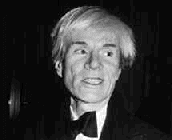 |
American artist and film maker, a leading exponent of the Pop art movement of the 1960s. Andy Warhol was born Andrew Warhola in Pittsburgh, Pennsylvania in 1928, of Czechoslovak immigrant parents. Upon graduation from the Carnegie Institute of Technology, Pittsburgh, Warhol moved to New York where he forged a successful career as a commercial artist. It was around this time that he shortened his surname to Warhol. Working as an illustrator for magazines and creating window displays allowed Warhol to explore some of the commercial themes and influences which would later contribute to the Pop art genre. Warhol first exhibited his work in the mid-Fifties, but it wasn't until the early Sixties that his career took off. Using commercial silkscreening techniques, Warhol was able to create identical, mass produced paintings using images from popular culture. Variations in colour gave each print of an edition a different look. The process of production itself apparently represented the throwaway consumerism of American culture. Between 1962 and 1964, Warhol enjoyed a prolific creative spell. The best-known examples of these Pop art works are the Campbell's Soup Cans (first painted in 1961), Brillo boxes, Coca-Cola bottles and his portraits of Marilyn Monroe. Warhol worked in his studio which he called 'The Factory', surrounded by hangers-on and 'street' people. In addition to painting, Warhol also made underground films, such as Chelsea Girls, Empire and Blow Job. Warhol also promoted the Velvet Underground on his travelling music, light and images show, known as 'The Exploding Plastic Inevitable'. He was credited with the production of their first album, for which he painted the famous banana sleeve. In 1968, Warhol was shot and almost killed by an obsessed female fan, who had previously appeared in some of his films. This experience changed the way he ran The Factory; he began to enjoy more of a celebrity lifestyle, moving amongst the rich and famous. Indeed, from 1969 until his death he published a celebrity-based magazine called 'Interview'. Warhol's own private life and sexuality were the source of much speculation. In the 1970s, having been firmly established as a major 20th-century artist and international celebrity, Warhol received numerous commissions to paint portraits. He exhibited his work extensively in museums and galleries around the world, and in the 1980s made TV shows and directed pop videos. Warhol died on February 22, 1987, following a routine gallbladder operation. Back |
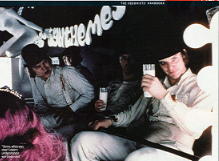 |
British actor, born in Leeds in 1943. After having his first screen role in Ken Loach's Poor Cow (1967)
consigned to the cutting room floor, he achieved his debut in Lindsay Anderson's If....
(1968), the first of three films he made with director Anderson and writer David Sherwin, documenting the adventures of
Mick Travis. McDowell's performance convinced Stanley Kubrick that this was the actor he wanted to portray Alex in his planned
adaptation of A Clockwork Orange, a role that was realised to iconic effect in 1971. In between, he appeared in
Joseph Losey's Figures In A Landscape (1970). McDowell was reunited with Lindsay Anderson for
the Everyman fable O Lucky Man! (1973). Other notable big screen appearances over the next ten years included Richard
Lester's historical comedy Royal Flash (1975) (with Oliver Reed), WWI drama Aces High
(1976) and the time-travel thriller Time After Time (1979), in which he played HG Wells. McDowell began the Eighties
with the lead role in the controversial and explicit Caligula (1980), which may have damaged his career prospects.
Although he was reunited with Anderson and Sherwin in 1982 for the last instalment of Mick Travis's odyssey, Britannia Hospital,
for much of the 80s and 90s he appeared in a string of largely forgettable B-movies which, as he freely admits, at least paid the mortgage.
A role which brought him back into the public eye was that of Dr Tolian Soran in the seventh Star Trek film, Star Trek:
Generations (1994), which gained him notoriety amongst fans as the character was responsible for the long overdue death of
Captain Kirk. McDowell augmented his film appearances in the 80s and 90s with regular TV work, particularly in the US. In 2000 he received
some acclaim for his appearance in the violent British gangster film, Gangster No. 1. Back Pictured: Alex (right), played by Malcolm McDowell, enjoys a glass of 'milk-plus' in the Korova Milkbar in Stanley Kubrick's A Clockwork Orange. |
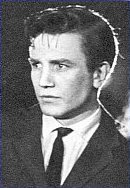 |
British actor, born in Salford, Manchester, in 1936. Finney made his professional stage debut in 1956,
finding acclaim in several Shakespearian productions. In 1960 he made his film debut playing Laurence
Olivier's son in Tony Richardson's The Entertainer. He next found success as the working-class
hero Arthur Seaton in Karel Reisz's Saturday Night And Sunday Morning (1960), one of the earliest
'kitchen sink' dramas. Tony Richardson later cast him in the title role of Tom Jones (1963), which
made Finney an international star and a millionaire, and earned him the first of his four Oscar nominations for Best
Actor. In 1967 he appeared alongside Audrey Hepburn in the popular Two For The Road. Another popular
role was that of Ebenezer Scrooge in the musical Scrooge (1970). Playing Hercule Poirot in the all-star
cast of Murder On The Orient Express (1974) earned him his second Oscar nomination. In 1983, he appeared
alongside Tom Courtenay in The Dresser, picking up a third nomination. Finney's
fourth nomination was for the film Under The Volcano (1984), directed by John Huston. The 90s saw Finney
make further film and TV appearances, including a reunion with Tom Courtenay for the BBC TV drama A Very English
Marriage. The actor appeared in 2000 alongside Julia Roberts in Erin Brockovich, for which he
was Oscar nominated. Back Pictured: Finney as Arthur in Saturday Night And Sunday Morning. |
 |
British actor, born in Hull in 1937. He shot to fame in his second film, the screen version of Alan Sillitoe's novel
The Loneliness of the Long Distant Runner (1962), directed by Tony Richardson. More acclaim followed for
his title role in Billy Liar (1963), his appearance in Joseph Losey's King
And Country (1964) and in Doctor Zhivago (1965), for which he won an Oscar nomination. At the
beginning of the Seventies, Courtenay took the decision to turn his back on films and concentrate on the theatre. However, he
returned to the big screen in 1983 with The Dresser, starring alongside Albert Finney,
which earned him a second Oscar nomination. Both actors were reunited in 1998 for the BBC TV drama A Very English
Marriage. The actor received a knighthood in the Queen's New Year Honours list of 2001.Back Pictured: Billy Fisher (left), played by Tom Courtenay, performs an irreverent soft shoe routine with his best mate Arthur (Rodney Bewes) on the steps of the town's War Memorial in Billy Liar (1963). |
 |
British actress. She had the lead role in Ken Loach's gritty TV play Cathy Come Home
(1965), alongside actor Ray Brooks, which exposed the scandal of the private rented housing sector and gave a boost to the newly-founded
charity for the homeless, Shelter. Earlier that year, she had taken the lead role in Loach's TV play Up The Junction, which
highlighted the often-fatal consequences of 'backstreet' abortions prior to legalisation in 1967. White appeared in a third Ken Loach work,
the feature film Poor Cow (1967), before relocating unsuccessfully to Hollywood. Back Pictured: Carol White in Poor Cow. |
 |
British actor, probably better known for his heavy drinking, hell-raising lifestyle, which
unfortunately detracted attention from his acting ability. Reed gained his break in 1959 when the horror film
company Hammer signed him up; his most memorable feature for them is The Curse Of The Werewolf
(1961). He appeared as a savage gang leader in Joseph Losey's The Damned
(1963), which apparently inspired Anthony Burgess to write A Clockwork Orange. Reed then featured
in several films by director Michael Winner, including The System and The Jokers
(both 1966) and Hannibal Brooks (1969). Ken Russell was also a director who appreciated Reed's appeal.
They first worked together on Russell's television docu-dramas, prior to the director's adaptation of DH Lawrence's
Women in Love (1969), which cast Reed opposite Glenda Jackson and included the infamous scene in which
Reed and Alan Bates wrestle naked. The Devils (1971) and The Who's Tommy (1975) were to
follow. In 1968, Oliver's uncle, the director Sir Carol Reed, cast him as Bill Sikes in the musical Oliver!
which made him an international star. Undoubtedly, his reputation for heavy drinking lost him more roles than were won.
Reed also gained a reputation towards the end of his life for seedy and subversive appearances on chat shows.
He died of a heart attack in May 1999, during a drinking session in a bar in Malta during the filming of what was to be
his final film, Ridley Scott's Gladiator. Note also that Carol White was amongst the many women with whom he had affairs. She was his co-star in Michael Winner's 1967 film I'll Never Forget What's 'is Name. Back Pictured: Oliver Reed and Mark Lester in Oliver!. |
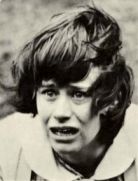 |
English actress, born in Liverpool in 1942. Tushingham made her striking screen debut in 1961 in the film version of Shelagh
Delaney's play A Taste Of Honey, directed by Tony Richardson. It was a role she secured
after answering a newspaper advertisement, and her performance won her the best actress award at the Cannes film festival that year.
She went on to appear in The Leather Boys (1963) - a favourite of Morrissey, Girl With Green Eyes (1964),
The Knack (1965, directed by Richard Lester), Doctor Zhivago (1965) (alongside Tom Courtenay),
The Trap (with Oliver Reed), Smashing Time (1967), The Guru
(filmed in 1969, this satirised George Harrison's infatuation with India) and Spike Milligan's nuclear war satire The Bed Sitting Room
(1969 - also directed by Richard Lester). Tushingham continued to make big screen appearances throughout the Seventies and Eighties, although these
were limited following a move to Canada and the demands of raising a family. Her return to England saw her attract praise for supporting roles
in films including The Boy From Mercury (1996), Swing and Out of Depth (both 1999). Since 2000, she has
appeared in several TV roles.
Back Pictured:Rita Tushingham as Jo, in Tony Richardson's A Taste Of Honey. |
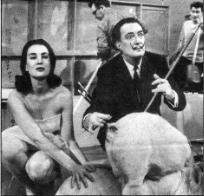 |
Spanish artist and printmaker, the pre-eminent painter of the Surrealist movement. Studying at art college in Madrid in the early 1920s revealed Dalí to have a gift for academic technique. In the late 1920s he discovered Sigmund Freud's writings on subconscious imagery, which greatly influenced his work. He developed links with the Paris group of Surrealists, through the patronage of Joan Miró, and joined them in 1929. Between 1929 and 1937 he produced the paintings that made him the world's most famous representative of the movement. His own flamboyant talent for self-publicity undoubtedly assisted in this. In order to bring up images from his subconscious mind to use in his work, Dalí would put himself into an hallucinatory state, a process he described as 'paranoiac critical.' Perhaps his most famous piece is The Persistence of Memory (1931), in which limp, melting watches reside in an landscape which resembles his Catalan homeland. Dalí himself described this painting as being a 'hand-painted dream photograph'. With the Spanish director Luis Buñuel, Dalí also made two Surrealistic films - Un Chien Andalou (1928) and L'Âge d'or (1930). He also contributed a celebrated dream sequence to Alfred Hitchcock's Spellbound (1945). Increasingly at odds with the Surrealist movement, he was expelled after a 'trial' in 1934. Thereafter, he switched to a more academic style, known as his 'classic' period. Influenced by the Renaissance painter Raphael, many of Dalí's works from this period were devoted to scientific, historical or religious themes. Dalí and his wife Gala moved to the United States to escape WWII, living there from 1940-48. From 1950-70, Dalí's work focussed on religious themes and childhood memories although sexual subjects and pictures centring on his wife Gala were also continuing preoccupations. In old age, Dalí became a recluse, increasingly so after the death of his wife in 1982, and after being badly burned in a fire at his house in 1986. Back |
 |
Spanish artist, one of the foremost exponents of abstract art and Surrealism. Miró was born in 1893 in Barcelona. He had an unconventional introduction to the study of art, only attending art school from the age of 18 after an unhappy spell in conventional employment. He moved to Paris in 1919 and met Pablo Picasso, Ernest Hemingway and others who would later become surrealists. Unlike his contemporary Picasso, Miró moved alternately between the French capital and his Catalan homeland. His early work revealed the influences of Cubism and Catalan folk art (amongst others). Inspired by his Surrealist friends, between 1925 and 1928 Miró painted his 'dream pictures'. Miró attempted to paint visual representation of Surrealist poetry and fantasy, seeking to discover signs and images that stood for concepts of nature in a poetic sense. Recurring elements of his art include amorphous shapes, hieroglyphic-like symbols, sharply drawn lines and spots of bright colour. In the 1930s, Miró extended his ideas into the design of tapestries, murals and monuments. In the years following WWII, Miró became world-famous, and was often in demand to produce murals and frescoes for public spaces. Back |
 |
British painter, born in London in 1931. One of the leading artists of the Op Art movement in
the Sixties. Op Art is short for Optical Art. This style is abstract by nature and is based on
producing optical illusions of movement, colour and topography with a stationary two-dimensional
surface, exploiting the fallibility of the eye. The principal artists of the Op Art movement as it
developed in the late 1950s and '60s were Victor Vasarely, Bridget Riley, Richard Anuszkiewicz,
Larry Poons, and Jeffrey Steele. It reached its peak in popularity in the mid 1960's and then
soon faded away but enjoyed a small resurgence in the 1980's. Back Well-known Riley paintings include: Movement In Squares (1961), Blaze 4 (1964), Drift 2 (1966) and Nineteen Greys (1968). |
 |
American actor, director, screenwriter and playwright, born Allen Stewart Konigsberg in Brooklyn, New York, in 1935. Woody began his career in the mid-Fifties as a gag writer, before commencing his own stand up act in the early 60s. The success of this led to a commission in 1965 to write the comedy What's New, Pussycat, in which he also had a cameo role. In 1966 he directed his first film, What's Up, Tiger Lily? Woody appeared in the James Bond spoof Casino Royale (1967) before embarking on his own film career as a writer / director with Take the Money and Run (1969). He strengthened his reputation with the subsequent comedies Bananas (1971), the episodic Everything You Always Wanted to Know About Sex (But Were Afraid to Ask) (1972) and Sleeper (1973). Allen's breakthrough came in 1977, with the Academy Award-winning Annie Hall. The bittersweet and deeply personal script established a new kind of sophisticated comedy, which was further developed in his next film, Manhattan (1979). Allen generally makes at least one film per year. The roles he frequently plays are a neurotic New Yorker involved in complicated love situations. He rarely films outside of his beloved New York, the city which provided the memorable backdrop to Manhattan. Allen frequently uses a small pool of favoured actors in his films and often cast his partner in the leading female role. Thus, he made eight films with Diane Keaton (mostly in the 70s) and eleven films with Mia Farrow (1982 - 92). Allen suffered a very public split with Farrow shortly after making Husbands and Wives (1992), after it was revealed that he had begun a relationship with Farrow's adopted daughter (whom he later married). In 1996, Woody directed his first musical, Everyone Says I Love You. Also worthy of a mention is the influence of the Swedish filmmaker Ingmar Bergman - see Interiors (1978), A Midsummer Night's Sex Comedy (1982) and September (1987). Allen also plays the clarinet in his own jazz band. Back |
 |
Hugely influential Spanish painter, sculptor and ceramicist, and one of the greatest artists of the 20th century. Although born in Spain, Picasso spent most of his life in France. He moved with his family to the Catalan capital Barcelona in 1895. After a brief spell at the Royal Academy of San Fernando in Madrid in 1897, the young Picasso began documenting life on the streets of the city. He first visited Paris in 1900, moving there permanently in 1904. Picasso's work can be classified under several periods. The suicide of his best friend Casagemas ushered in the so-called Blue Period (1901-4), which saw the use of dark colours and sombre-looking figures. Late 1904-6 saw him enter his Rose Period, in which the beige tones found in pottery, flesh and earth were explored. This period also witnessed the introduction of circus figures, particularly clowns, which were recurring elements in Picasso's oeuvre. From 1909-12 Picasso worked with the French artist Georges Braque, and taking inspiration from the work of Cézanne, they pioneered Cubism. This became the most influential style of art during the first half of the 20th century; this new style expressed space in strongly geometric terms and explored the notion of multiple viewpoints, depicting people and objects from several angles within the same painting. Between the wars, Picasso had intimate connections with the then-dominant Surrealism movement, but he remained aloof from the group. It did, however, provide him with new subjects, often of an erotic nature. By the late 1930s, Picasso was the most famous artist in the world. His sympathies to the Republican cause during the Spanish Civil War (1936-39) led to the commission of the monumental Guernica (1937), which depicted the brutality of fascist aggression, inspired by the bombing of the Basque town. In the last two decades of his long career, Picasso produced more work than at any other time of his life. His late work was influenced by the history of art - he made references to other artists and also re-interpreted his own output. Virtually no 20th-century artist has escaped his influence. Back |